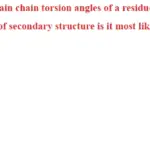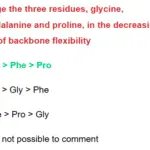![]()
In a polypeptide chain, a cis-to-trans rearrangement of two consecutive proline residues can be achieved by rotating the:
(1) O angle to 10°
(2) ω angle to 180°
(3) Ψ angle to 0°
(4) x angle to 60°
In a polypeptide chain, cis-to-trans isomerization primarily involves rotation around the peptide bond (ω angle).
- ω (omega) angle represents the dihedral angle around the peptide bond.
- In a cis conformation, ω ≈ 0°.
- In a trans conformation, ω ≈ 180°.
Analyzing the options:
- O angle to 10° → Incorrect, as O is not a standard torsion angle in peptide bonds.
- ω angle to 180° → Correct, as flipping from cis (ω ≈ 0°) to trans (ω ≈ 180°) directly achieves the rearrangement.
- Ψ angle to 0° → Incorrect, because Ψ (psi) refers to the Cα–C bond rotation and does not determine cis-trans isomerization.
- χ (chi) angle to 60° → Incorrect, as χ angles refer to side-chain rotations, not peptide bond isomerization.
Correct Answer:
(2) ω angle to 180°









